Pros
-
Cool and quiet
-
Performance
-
Connectivity options
Cons
-
Space limitations
About the Intel NUC 11 Extreme Kit
Here are the specs on the model we tested:
- Processor: Intel Core i9-11900KB
- Memory: 16GB DDR4-3200 DRAM
- Storage: 500GB PCIe 4.0 NVMe M.2 SSD
- Ports: 2.5 Gbps Ethernet, 2x USB-C Thunderbolt 4, 8x USB-A 3.2 Gen 2, HDMI 2.0b, SD card, headphone jack
- Graphics: Nvidia GeForce RTX 3060
- Wireless: Wi-Fi 6E, Bluetooth 5.2
- Dimensions: 8-liters (14.0 x 7.4 x 4.7 inches)
Intel’s NUC 11 Extreme Kit can be configured with either a Core i7 or a Core i9 processor. (Unfortunately, Intel is not offering a Core i5 configuration due to low demand.) As long as the discrete GPU is 12-inches long or shorter, and it doesn’t need more than 350W of power, it will theoretically fit inside the case. The desktop also comes with four M.2 SSD slots, two PCIe 4.0 and two PCIe 3.0, one of which you can access via a panel on the bottom of the desktop.
What we like
Dead silent, cool as a cucumber
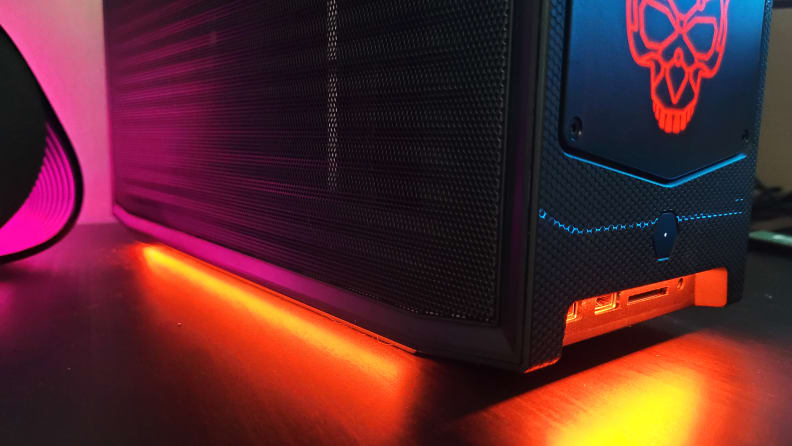
The RGB lighting is a nice, extra touch on the Intel NUC 11 Extreme Kit.
A powerful gaming rig that doesn’t sound like a plane taking off? That’s a special kind of silence. Intel’s NUC 11 Extreme Kit is like an ASMR video with inaudible whispers: pleasantly quiet. It’s so quiet you’ll forget it's on, whether you’re browsing the web or pushing the desktop to its gaming limits.
On the underside of the top panel, there are three 92mm fans that push the hot air out. On the right side, there’s one intake fan. A regular-sized desktop would normally have multiple intake fans and one or two outtake fans, which makes it all the more impressive that the chassis stays as cool as it does with only three small fans pumping out the hot air.
It’s also surprising how cool the processor stays with an even smaller fan and just one at that. From what we’ve seen in our testing, Intel’s mobile processors have a penchant for butting up against their thermal limits, usually hitting around a maximum temperature of 98 degrees Celsius (208 Fahrenheit). The CPU in our Intel NUC 11 Extreme Kit reached the same max temperature and averaged around 65 C (149 F), but with only one tiny fan to keep it cool. The gaming laptops with equivalent Intel chips usually have more robust cooling solutions that combine the use of fans with heatsinks to keep the temps down as low as possible.
It’s possible that enclosing the CPU in its own housing unit (AKA a compute element) helps mitigate the temperatures, but whatever is making the magic happen, we’re into it.
Performance, performance, performance
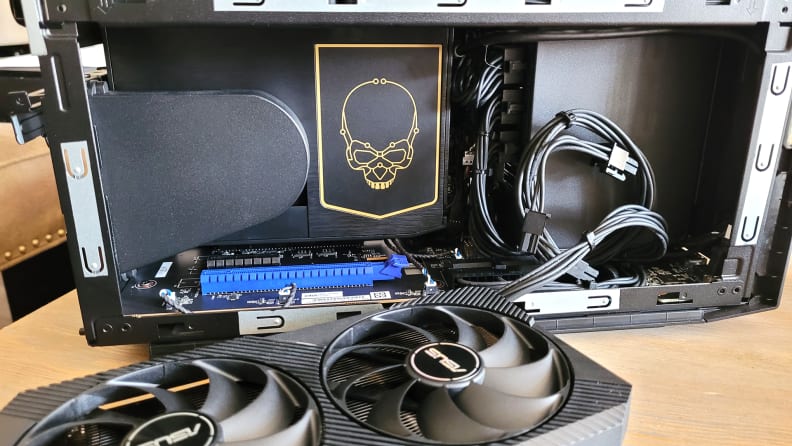
The Intel NUC Extreme Kit houses its processor in the compute element—or the component in the base with the skull logo on it.
One of the perks about the Intel NUC 11 Extreme Kit is you can put any GPU you want in it. It just needs to be small enough to fit and have the right power ports, and you’re set. Okay, so that’s not any GPU, but just know you’re not stuck with an RTX 3060.
After running our usual tests with the stock RTX 3060, we swapped it out for an RTX 3060 Ti Founders Edition GPU without completely taking the chassis apart. On average, we saw a 15-20 frame rate increase across all games at all screen resolutions after the switch. For example, with the RTX 3060, the desktop nets 124 fps on Far Cry 5 at 1080p with the ultra graphics preset enabled, but the RTX 3060 Ti pumps out 138 fps.
For those of you who want to play games with ray tracing (i.e. incredibly realistic lighting effects) turned on, the RTX 3060 can manage 48 fps in Control at 1080p at the highest graphics preset, but the RTX 3060 Ti can push you over 60 fps. If you want better graphics performance, you’ll need to scale up the GPU, but there are some issues with doing that. (More on that in a bit.)
If you’re looking for a tiny PC to handle all your creative projects, the CPU in this Intel NUC 11 Extreme Kit is more than up to the task. When we rendered a 3D image of a BMW in Blender, a free and open-source 3D creation suite, it took only three and a half minutes with the CPU. That’s on par with what AMD’s Ryzen 9 5900HX can do when we ran the same test on the Asus ROG Strix G15 AMD Advantage Edition. The Core i9-11900KB is an 8-core/16-thread capable of reaching clock speeds up to 5.30GHz—in tech speak that means really freakin’ fast, so expect to get a lot out of it.
Loaded with ports
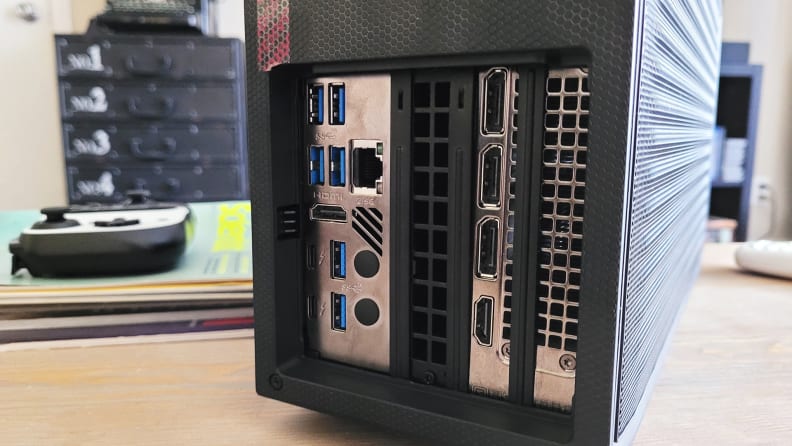
The Intel NUC 11 Extreme Kit comes with more connectivity ports than most people will need, but that's not a bad thing. You can never have enough ports.
Intel thought ahead and included enough ports for a variety of uses. With a total of eight USB-A ports, two USB-C Thunderbolt 4 ports, HDMI, SD card reader, Ethernet port, and a headphone jack, this mini desktop has more ports than most people will ever need. And that’s how it should be.
If you’re looking to downsize your rig, especially if you’re a streamer, you have enough space for all the basic streaming equipment plus some extra ports if you wanted to add a stream deck to your setup. I was able to connect my keyboard, mouse, webcam, microphone, external speakers, headphones, and a photo scanner, leaving the two Thunderbolt ports open.
What we don’t like
A tight squeeze
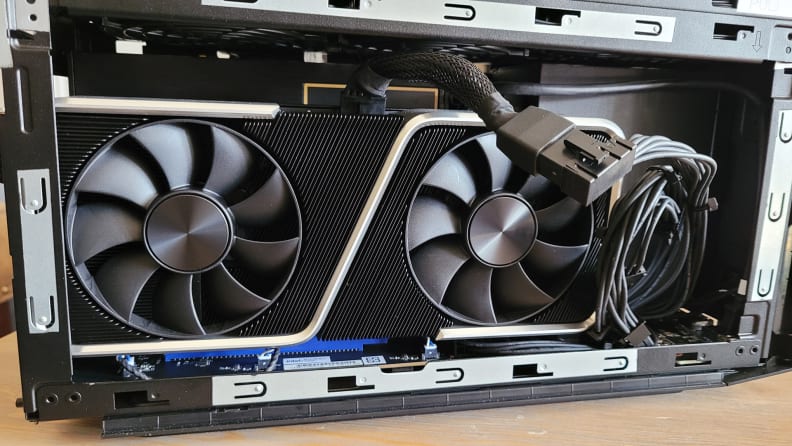
We were able to fit an Nvidia GeForce RTX 3060 Ti inside, but not without bending the power adapter cable to make it fit inside.
Here’s the thing about mini desktop PCs: they’re small enough to put them on top of your desk without losing too much real estate, but you either need tiny hands or tiny tools to rearrange the insides—and may the silicon gods help you if you drop a screw somewhere inside the case. Intel’s NUC 11 Extreme Kit is an eight-liter case, meaning there’s barely enough space for Intel’s NUC compute element, a discrete GPU, and other necessary components and cables. Accessing the GPU to swap it out is easy, and the case can fit up to a 12-inch GPU, but the bigger the GPU, the less space there is to push cables out of the way. While we were able to fit an Nvidia RTX 3060 Ti Founders Edition inside, when we tried an RTX 3070 Founders Edition, its special power pin adapter made it too tall to fit under the top fans.
Instead of a standard 8-pin power port, Nvidia uses a proprietary 12-pin port on all its RTX 30-series graphics cards from the RTX 3060 Ti and up. The GPU power connector that comes with this Intel NUC 11 Extreme Kit is an 8-pin, so you’ll need to use Nvidia’s included adapter to connect the GPU to the cable. Intel included an RTX 3060 with our review unit, which uses a regular 8-pin port, so there was no issue there.
The RTX 3060 Ti adapter is short and chunky, but if you position it right you can fit it under the fans. The RTX 3070 adapter is a whole different story: since it needs more power, its adapter looks like a two-headed snake. Two 8-pin ports connect to a single 12-pin plug, and the 12-pin side sticks straight up, which causes the GPU to exceed the height limit inside the case. There isn’t enough room between the adapter and the fans to make it work.
AMD Radeon GPUs, though? All of those have the standard 8-pin ports, so as long as the card is short enough to fit inside the case you won’t have to worry about shoving the cables into whatever gap you can find. We made the Radeon RX 6700 work, but barely. The same Nvidia and AMD GPUs from third-party manufacturers like Asus, MSI, Sapphire, etc. might also fit, but again it’s all about those pin ports and their placement on the GPU itself.
Pricing may be misleading
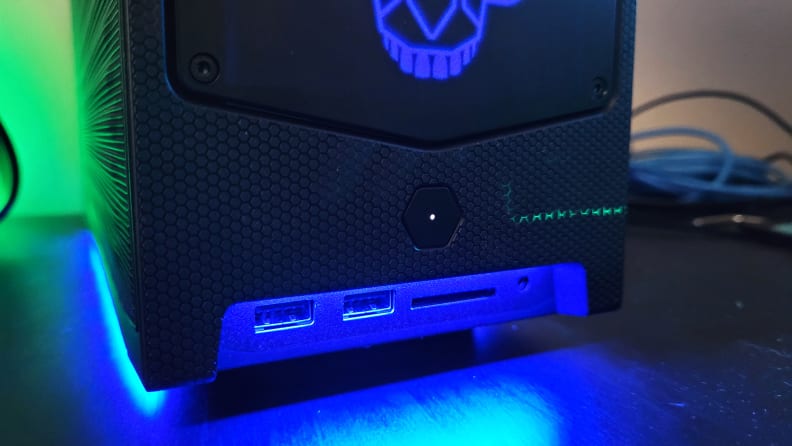
The Intel NUC 11 Extreme Kit comes with a total of 10 USB ports, among other connectivity options.
Pricing for Intel’s NUC 11 Extreme Kit stands out for one main reason: its $1,150-$1,350 price tag doesn’t include memory, storage, graphics card, or an operating system. (The compute element, or the board with the CPU on it, individually runs between $780-$980.) While this half bring-your-own-parts approach isn’t unique to this machine or anyone who has built a PC from scratch, it’s important to understand this so you don’t look at the price and go “Wow! So cheap!” without reading the fine print.
For review purposes, all of that was provided in the system we received, but anyone interested in purchasing one of these beastly little machines will need to bring their own parts—and that could tack on another $600 or $700, bringing the total cost to somewhere between $1,750-$2,050. The total cost will likely be more considering the sky-high prices of graphics cards these days and will depend on how much memory and storage you want.
But when you tally up the cost of building a regular-sized, high-end gaming PC to Intel’s NUC 11 Extreme Kit, the cost isn’t that much different. And with Intel’s NUC 11 kit, you don’t have to worry about finding a case, a power supply unit, or a cooling solution. All that is time saved.
Where Intel’s downfall lies compared to boutique builders is that it doesn’t provide a graphics card, one of, if not the hardest PC hardware components to find right now. Pre-built rigs from NZXT and other places include everything, so you don’t need to source any of your own parts. That’s more time saved compared to finding a CPU, case, cooler, and all the other parts that already come in the NUC 11 kit.
Should you buy it?
Yes, if you already have the right parts

It may be pint-sized, but Intel's NUC 11 Extreme Kit has the power of a full-sized desktop PC.
The Intel NUC 11 Extreme Kit is a powerhouse in a tiny package. It offers great rendering speeds, great gaming speeds, and you can pair it with almost any GPU you want. However, anyone who wants to go higher than an RTX 3060 Ti might have to take apart the top of the chassis to get it to fit, and even then there’s no guarantee you’ll be able to bend Nvidia’s power port adapter without damaging it.
If you love the form factor but hate that you can’t put any GPU you want in it, consider the Razer Tomahawk. Not only is it designed to work with an Intel NUC compute element, but it also fits larger GPUs like the RTX 3070, RTX 3080, and AMD’s Radeon RX 6800XT and RX 6800. But you’ll be paying a premium: Just the Razer Tomahawk chassis with an Intel compute element is $2,399.99—and the compute element is Intel’s last generation. (If you opt to get the version with an included RTX 3080, be prepared to pay well over $3,000.) Theoretically, Intel’s NUC 11 compute element should fit in there, but Razer doesn’t sell the Tomahawk case on its own at the moment.
If you have an RTX 3070 or higher, you might be better off getting something like the Cooler Master’s Masterbox NR200 mini desktop case. It’s seven inches taller than the Intel NUC 11 Extreme Kit but otherwise looks similar (minus the aggressive Intel NUC RGB skull logo on the front). But that case is made for traditional PC hardware, not an Intel NUC compute unit.
All of that said, the Intel NUC 11 Extreme Kit is a fantastic machine for anyone who likes to build tiny PCs, and it’s a more robust, more powerful alternative to something like the Mac Mini. It’s reasonably priced compared to DIY alternatives, it looks cool, and while it may be a niche desktop PC, mini PC enthusiasts who already have the right parts for it should consider it over a traditional PC.
Meet the tester
Joanna specializes in anything and everything gaming-related and loves nerding out over graphics cards, processors, and chip architecture. Previously she was a staff writer for Gizmodo, PC Gamer, and Maximum PC.
Checking our work.
Our team is here to help you buy the best stuff and love what you own. Our writers, editors, and experts obsess over the products we cover to make sure you're confident and satisfied. Have a different opinion about something we recommend? Email us and we'll compare notes.
Shoot us an email



